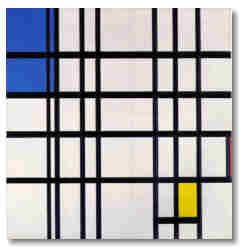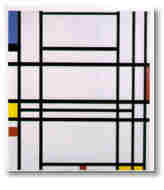


(1872-1944)
Mondrian began his career as a landscape painter after obtaining academic training In Amsterdam. Toward 1908, he began to lighten his palette and work in a neo-Impressionist manner until, in 1911, he took a studio in Paris and began a serious study of Cuhism. Mondrian's approach to Cubist principles soon led him far from figurative allusion. By 1914, when he returned to Holland, he had already reduced landscape motifs to their geometric essentials. In 191 7 he wrote his aesthetic credo ,calling his new style Neoplasticism, and with Theo van Doesburg founded the de Styl group. Mondrian's austere white canvases, with their vertical and horizontal lines and sparing use of primary colors, were important to the burgeoning schools of non objective artists, and were also influential in the fields of architecture and modern design. In 1938 Mondrian moved from Paris, where he had been living since 1919,to London, and in 1940 he settled in New York. There, he opened a new chapter in his theoretical exploration of line and color, composing works reflecting the urban rhythm of New York and its contemporary jazz.
MONDRIAN'S THOUGHTS ON ART
"Not everyone realizes that in all plastic
art, even in the most naturalistic work, the natural form and color are always, to some
extent, transformed. Actually while this may not be directly perceived, the tension of
line and form as well as the intensity of color are always increased. Plastic experience
demonstrates that the natural appearance of things is not to be established in its
essential realism, but must be transformed in order to evoke aesthetic sensation.
In the course of centuries, the culture of plastic art has taught us that this
transformation is actually the beginning of the abstraction of natural vision, which in
modern times manifests itself as abstract art. Although abstract art has developed through
the abstraction of the natural aspect, nevertheless in its present evolution it is more
concrete because it makes use of pure form and pure color.
Consciousness of the necessity of abstraction in plastic art was developed slowly.
Originally it was practiced intuitively. Only after centuries of in-creasing
transformation of the natural aspect, more apparent abstraction emerged, until finally
plastic art was freed from the particular characteristics of subject and object. This
liberation is of the greatest importance. For plastic art reveals that particular
characteristics veil the pure expression of form, color, and relationships. In plastic
art, form and color are the essential expressive means. Their properties and mutual
relationships determine the general expression of a work. Abstraction not only establishes
form and color more objectively but also reveals their properties more clearly. Thus we
can see that the abstraction of form and color merely "modifies" a work of art,
but that abstract art, even as naturalistic art, must create the general expression by
means of the composition. Through the composition and other plastic factors, it is
possible for a naturalistic work of art to have a more universal expression than a work of
abstract art which is lacking in the proper use of these factors.
We come to see that the principal problem in plastic art is not to avoid the
representation of objects, but to be as objective as possible. The name nonobjective art
must have been created with a view to the object, that is in another order of ideas.
Plastic art reveals that the principal expression of a work of art is dependent on our
subjective vision, which offers the major obstacle to objective representation of reality.
Objective vision-as far as possible-is the principal claim of all plastic art. If
objective vision were possible, it would give us a true image of reality.
 For
centuries, our vision has been increasingly enlarged through the development of life,
science, and technology. Consequently it has become possible to see more objectively.
However, intuitively, plastic art has always aimed at the universal expression of reality.
All plastic art establishes this expression through a dynamic movement of forms and
colors. But abstract art, in, opposition to naturalistic art, can do this more clearly and
in conformity with modern times. It must be stated, however, that the judgment of a work
of art depends on the individual vision of it. What may be clear for some one may appear
vague to another. This fact explains the existence of different tendencies in the same
epoch. Abstract art manifests clearly the conception and feelings which give birth to a
work of art as well as the laws"
For
centuries, our vision has been increasingly enlarged through the development of life,
science, and technology. Consequently it has become possible to see more objectively.
However, intuitively, plastic art has always aimed at the universal expression of reality.
All plastic art establishes this expression through a dynamic movement of forms and
colors. But abstract art, in, opposition to naturalistic art, can do this more clearly and
in conformity with modern times. It must be stated, however, that the judgment of a work
of art depends on the individual vision of it. What may be clear for some one may appear
vague to another. This fact explains the existence of different tendencies in the same
epoch. Abstract art manifests clearly the conception and feelings which give birth to a
work of art as well as the laws"